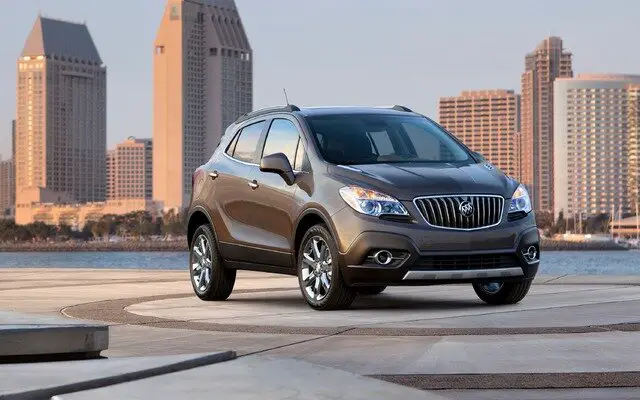Buick Encore 2015 Owner’s Manual
The 2015 Buick Encore is a small luxury crossover SUV that combines style, flexibility, and high-tech features in a smaller size. The Encore stands out on the road thanks to its sleek and modern design. It also has a comfy and stylish interior. Even though the Encore is small, it has a cabin that is fairly big and can fit up to five people. It has a turbocharged engine that gives it both speed and good gas mileage. The Encore also has a number of high-tech features, like a touchscreen infotainment system that works with smartphones and safety features like blind-spot tracking and lane departure warning that can be added as options. The 2015 Buick Encore is a stylish and useful choice for people who live in cities or want a smaller luxury crossover SUV because it is easy to drive and small.
When Should an Airbag Inflate?
This vehicle is equipped with airbags. See Airbag System on page 3-23. Airbags are designed to inflate if the impact exceeds the specific airbag system’s deployment threshold. Deployment thresholds are used to predict how severe a crash is likely to be in time for the airbags to inflate and help restrain the occupants. The vehicle has electronic sensors that help the airbag system determine the severity of the impact. Deployment thresholds can vary with specific vehicle design.
Frontal airbags are designed to inflate in moderate to severe frontal or near frontal crashes to help reduce the potential for severe injuries, mainly to the driver’s or front outboard passenger’s head and chest.
Whether the frontal airbags will or should inflate is not based primarily on how fast the vehicle is traveling.
It depends on what is hit, the direction of the impact, and how quickly the vehicle slows down.
Frontal airbags may inflate at different crash speeds depending on whether the vehicle hits an object straight on or at an angle, and whether the object is fixed or moving, rigid or deformable, narrow or wide.
Frontal airbags are not intended to inflate during vehicle rollovers, in rear impacts, or in many side impacts.
In addition, the vehicle has advanced technology frontal airbags. Advanced technology frontal airbags adjust the restraint according to crash severity.
Knee airbags (if equipped) are designed to inflate in moderate to severe frontal or near frontal impacts. Knee airbags are not designed to inflate during vehicle rollovers, in rear impacts, or in many side impacts.
Seat-mounted side impact airbags are designed to inflate in moderate to severe side crashes depending on the location of the impact.
Seat-mounted side impact airbags are not designed to inflate in frontal impacts, near frontal impacts, rollovers, or rear impacts.
A seat-mounted side impact airbag is designed to inflate on the side of the vehicle that is struck.
Roof-rail airbags are designed to inflate in moderate to severe side crashes depending on the location of the impact. In addition, these roof-rail airbags are designed to inflate during a rollover or in a severe frontal impact. Roof-rail airbags are not designed to inflate in rear impacts. Both roof-rail airbags will inflate when either side of the vehicle is struck, if the sensing system predicts that the vehicle is about to roll over on its side, or in a severe frontal impact. In any particular crash, no one can say whether an airbag should have inflated simply because of the vehicle damage or repair costs.
What Makes an Airbag Inflate?
In a deployment event, the sensing system sends an electrical signal triggering a release of gas from the inflator. Gas from the inflator fills the airbag causing the bag to break out of the cover. The inflator, the airbag, and related hardware are all part of the airbag module.
For airbag locations, see Where Are the Airbags? on page 3-25.
How Does an Airbag Restrain?
In moderate to severe frontal or near frontal collisions, even belted occupants can contact the steering wheel or the instrument panel. In moderate to severe side collisions, even belted occupants can contact the inside of the vehicle.
Airbags supplement the protection provided by safety belts by distributing the force of the impact more evenly over the occupant’s body. Rollover-capable roof-rail airbags are designed to help contain the head and chest of occupants in the outboard seating positions in the first and second rows. The rollover-capable roof-rail airbags are designed to help reduce the risk of full or partial ejection in rollover events, although no system can prevent all such ejections.
But airbags would not help in many types of collisions, primarily because the occupant’s motion is not toward those airbags. See When Should an Airbag Inflate? on page 3-27. Airbags should never be regarded as anything more than a supplement to safety belts.
What Will You See after an Airbag Inflates?
After the frontal, knee (if equipped), and seat-mounted side impact airbags inflate, they quickly deflate, so quickly that some people may not even realize an airbag inflated. Roof-rail airbags may still be at least partially inflated for some time after they inflate. Some components of the airbag module may be hot for several minutes. For location of the airbags, see Where Are the Airbags? on page 3-25. The parts of the airbag that come into contact with you may be warm, but not too hot to touch. There may be some smoke and dust coming from the vents in the deflated airbags. Airbag inflation does not prevent the driver from seeing out of the windshield or being able to steer the vehicle, nor does it prevent people from leaving the vehicle.
Warning
When an airbag inflates, there may be dust in the air. This dust could cause breathing problems for people with a history of asthma or other breathing trouble.
To avoid this, everyone in the vehicle should get out as soon as it is safe to do so. If you have breathing problems but cannot get out of the vehicle after an airbag inflates, then get fresh air by opening a window or a door. If you experience breathing problems following an airbag deployment, you should seek medical attention.
The vehicle has a feature that may automatically unlock the doors, turn on the interior lamps and hazard warning flashers, and shut off the fuel system after the airbags inflate.
The feature may also activate, without airbag inflation, after an event that exceeds a predetermined threshold. You can lock the doors,
and turn off the interior lamps and hazard warning flashers by using the controls for those features.
Warning
A crash severe enough to inflate the airbags may have also damaged important functions in the vehicle, such as the fuel system, brake and steering systems, etc. Even if the vehicle appears to be drivable after a moderate crash, there may be concealed damage that could make it difficult to safely operate the vehicle.
Use caution if you should attempt to restart the engine after a crash has occurred.
In many crashes severe enough to inflate the airbag, windshields are broken by vehicle deformation.
Additional windshield breakage may also occur from the front outboard passenger airbag
- Airbags are designed to inflate only once. After an airbag inflates, you will need some new parts for the airbag system.
If you do not get them, the airbag system will not be there to help protect you in another crash. A new system will include airbag modules and possibly other parts. The service manual for the vehicle covers the need to replace other parts. - The vehicle has a crash sensing and diagnostic module which records information after a crash. See Vehicle Data Recording and Privacy on page 13-14 and Event Data Recorders on page 13-14.
- Let only qualified technicians work on the airbag systems. Improper service can mean that an airbag system will not work properly. See your dealer for service.
Passenger Sensing System
The vehicle has a passenger sensing system for the front outboard passenger position. The passenger airbag status indicator will light on the instrument panel when the vehicle is started.
The words ON and OFF, or the symbol for on and off, will be visible during the system check. When the system check is complete, either the word ON or OFF, or the symbol for on or off, will be visible. See Passenger Airbag Status Indicator on page 5-12. The passenger sensing system turns off the front outboard passenger frontal airbag and knee airbag (if equipped) under certain conditions. No other airbag is
affected by the passenger sensing system.
The passenger sensing system works with sensors that are part of the front outboard passenger seat. The sensors are designed to detect
the presence of a properly seated occupant and determine if the front outboard passenger frontal airbag and knee airbag (if equipped) should be allowed to inflate or not. According to accident statistics, children are safer when properly secured in a rear seat in the correct child restraint for their weight and size. Whenever possible, children age 12 and under should be secured in a rear seating position.
Never put a rear-facing child seat in the front. This is because the risk to the rear-facing child is so great, if the airbag inflates.
FAQ
A1: The Buick Encore 2015 comes with a 1.4-liter turbocharged four-cylinder engine.
A2: The Buick Encore 2015 can comfortably seat up to five passengers.
A3: Yes, all-wheel drive is available as an option for the Buick Encore 2015.
A4: The fuel efficiency of the Buick Encore 2015 varies depending on the drivetrain. On average, it achieves around 25-28 mpg in the city and 33-34 mpg on the highway.
A5: The Buick Encore 2015 comes with standard safety features such as antilock brakes, stability control, traction control, airbags, and a rearview camera. Available safety features may include blind-spot monitoring, rear cross-traffic alert, and forward collision alert.
A7: Yes, the Buick Encore 2015 is equipped with a touchscreen infotainment system that includes features such as Bluetooth connectivity, smartphone integration, and available navigation.
A8: Yes, the Buick Encore 2015 offers available leather-appointed seating for added comfort and luxury.
A9: The Buick Encore 2015 offers available advanced driver-assistance features such as blind-spot monitoring, rear cross-traffic alert, and forward collision alert.
A10: The Buick Encore 2015 provides a cargo capacity of approximately 18.8 cubic feet behind the rear seats. With the rear seats folded down, the cargo capacity expands to around 48.4 cubic feet.
A11: Yes, the Buick Encore 2015 offers an available power sunroof for an open and airy feel.
A12: The Buick Encore 2015 is equipped with a six-speed automatic transmission.
A13: The Buick Encore 2015 is available in several trim levels, including the Base, Convenience, Leather, and Premium.
A14: Yes, the Buick Encore 2015 offers available heated front seats for added comfort during colder weather.
A15: Absolutely! The Buick Encore 2015 offers a combination of style, comfort, and advanced features that make it a compelling choice in the compact luxury crossover SUV segment.
Useful Link
Download Link: https://www.buick.com/support/vehicle/manuals-guides


